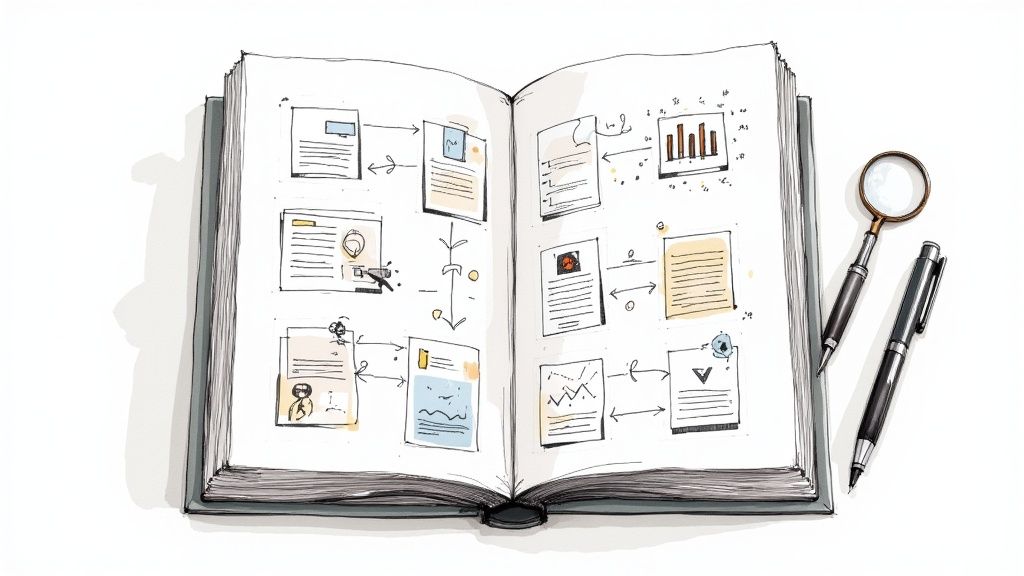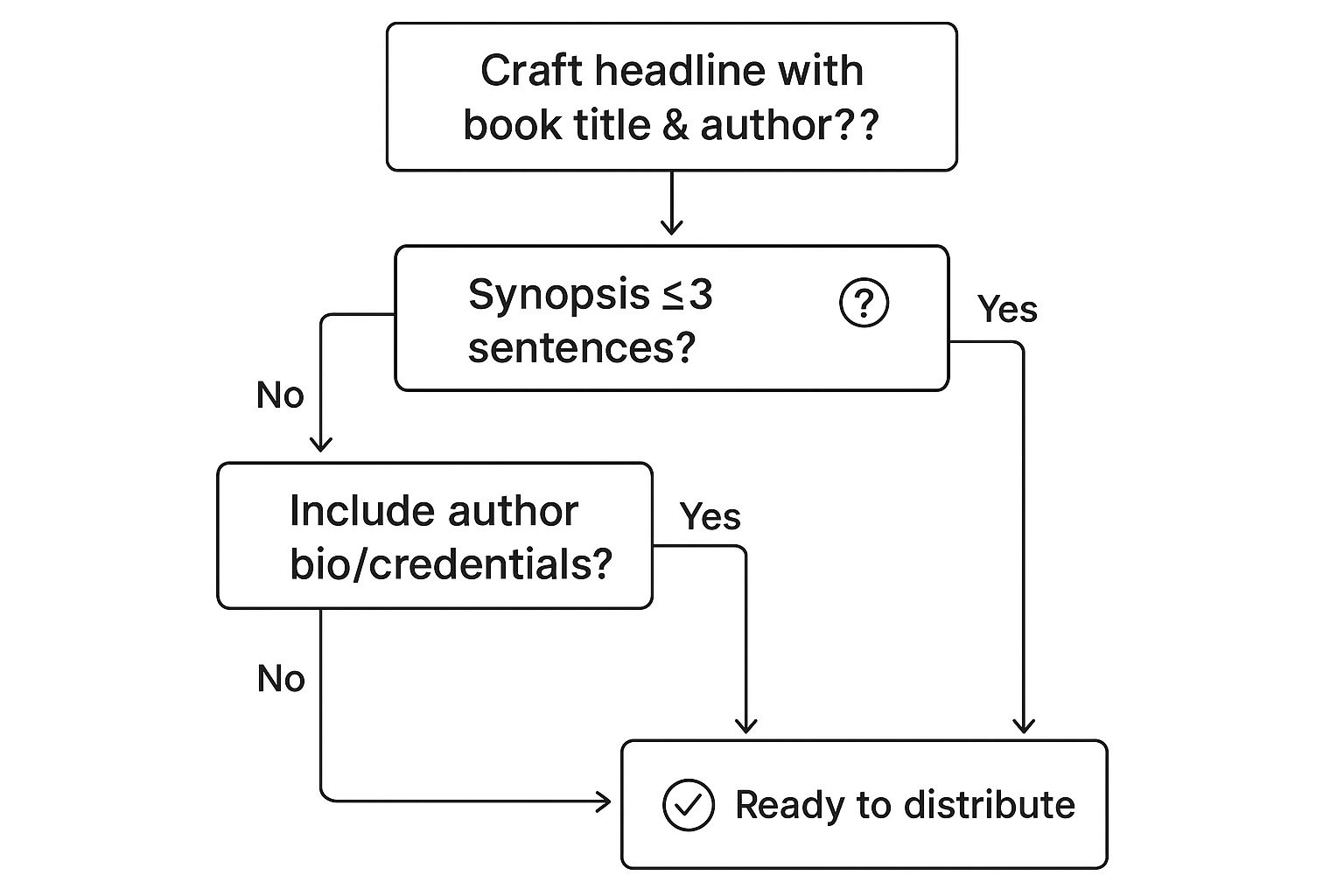6 Press Release Examples for Books: Craft a Winning Strategy

Unleash Your Book's Potential: Mastering the Art of the Press Release
A successful book launch hinges on effective promotion. Without media attention, even the best books can languish in obscurity. A well-crafted press release is your first line of defense against invisibility—it's the key to generating buzz and capturing media attention.
This guide provides six press release examples for books, covering various strategies, best practices, and actionable tips. You'll learn how to create compelling releases that resonate with your target audience and motivate journalists to cover your book.
We'll analyze examples like a strategist, dissecting what works and why. You'll gain tactical insights and replicable strategies to apply to your own book marketing. Whether you're announcing a new release, highlighting an award, or connecting with your local community, we've got you covered.
6 Proven Press Release Strategies
This guide covers diverse approaches to press release writing:
- The Classic Book Launch Announcement - Your foundation for any book release
- The Award-Winning or Recognition-Based Press Release - Leverage accolades for credibility
- The Trending Topic or Current Events Tie-In - Ride the wave of media attention
- The Human Interest or Personal Story Angle - Connect emotionally with readers
- The Expert Authority or Industry Insight Release - Position yourself as a thought leader
- The Local Community or Regional Interest Approach - Build grassroots support
Each example includes a breakdown of structure, tone, and key takeaways. We'll examine effective press releases and extract actionable advice. This deep dive into press release examples for books equips you with the tools to craft compelling narratives and maximize your book's visibility.
1. The Classic Book Launch Announcement
The classic book launch announcement is the cornerstone of book publicity. It's a traditional press release format designed to spread the word about a new book, highlighting its premise, author credentials, and publication details.
This straightforward approach emphasizes the book's value proposition and clearly identifies the target audience. Think of it as the official introduction of your book to the world—the foundation upon which other marketing efforts are built.
Examples of Success
Major publishers like Penguin Random House and HarperCollins consistently nail the classic launch announcement. Their press releases focus on core elements: concise synopsis, author expertise, and essential publication details. This approach generates pre-publication buzz and establishes a strong foundation for sales success.
Actionable Tips for Your Classic Launch Announcement
Crafting an effective classic book launch announcement hinges on several key elements:
- Lead with the hook: Grab attention immediately by highlighting the most compelling aspect of your book. Is it a unique plot twist? Groundbreaking research? The author's extraordinary background? Start with what makes your book stand out.
- Concise Synopsis: Keep your synopsis brief and impactful (2-3 sentences maximum). Focus on the core conflict and themes without giving away too much. Intrigue readers, don't overwhelm them.
- Credible Credentials: Include relevant author credentials that establish their authority and expertise. Previous publications, awards, relevant professional experience, and educational background all contribute to building trust and credibility.
- Active Voice and Present Tense: Use dynamic language that creates a sense of immediacy and excitement.
- High-Resolution Image: Include a professional, high-resolution image of your book cover. This visual element is crucial for grabbing attention and making a strong first impression.
When to Use a Classic Launch Announcement
The classic book launch announcement is the go-to strategy for most book releases. It's particularly effective for:
- Debut authors - Establishing credibility and generating early interest
- Books with a clear target audience - Reaching specific reader groups with tailored messaging
- Non-fiction books based on expertise - Highlighting author credentials and unique value
Learn more about promoting your book and discover how to implement these tips effectively.

This classic approach remains powerful for book promotion across all genres and author platforms. By focusing on core elements and following best practices, you can generate buzz, attract readers, and drive book sales.
2. The Award-Winning or Recognition-Based Press Release
The award-winning or recognition-based press release leverages accolades, endorsements, or notable achievements to generate buzz around a book. This approach uses third-party validation to establish credibility and create newsworthiness, capturing media attention and reader interest. It positions the book's recognition as the primary news angle, showcasing its quality and significance.
Examples of Success
Major awards like the Pulitzer Prize generate significant media coverage when amplified by strategic press releases. Best-seller milestones and sales records create newsworthy moments. Even local writing competitions offer opportunities for regional media attention and community engagement.
Actionable Tips for Your Award-Winning Press Release
Maximizing the impact of an award or recognition requires a strategic approach:
- Immediate Release: Issue the press release immediately following the award announcement to capitalize on the news cycle.
- Specific Details: Include details about the award, the awarding organization, and the selection criteria. This adds weight and legitimacy to the announcement.
- Connect to Themes: Explain how the award relates to the book's themes, quality, or overall message. This strengthens the connection between the recognition and the book's value.
- Compelling Quotes: Include quotes from judges, critics, or other credible sources explaining why the book deserved recognition.
- Sales and Opportunities: Leverage the momentum to promote book sales, speaking engagements, and other related opportunities.
When to Use an Award-Winning Press Release
Subscribe & Get Your Free Marketing Plan Template
Receive regular updates on marketing best-practices, AI shortcuts, and get our proven 4-phase marketing roadmap for free.
Unsubscribe anytime.
This type of press release is ideal for:
- Books that have won awards: Announcing literary prizes, industry recognitions, or competition wins.
- Books achieving significant milestones: Highlighting best-seller status, record-breaking sales, or critical acclaim.
- Authors receiving prestigious endorsements: Showcasing positive reviews from influential figures or organizations.
By strategically highlighting achievements, you can elevate your book's visibility and establish its value within the literary landscape. This targeted approach significantly impacts media coverage, reader perception, and ultimately, book sales.
3. The Trending Topic or Current Events Tie-In
The trending topic or current events tie-in is a strategic press release that connects a book's content to current news, trending topics, or seasonal relevance. This approach leverages existing media interest in specific subjects to create newsworthiness for the book. It capitalizes on the public's current focus, inserting the book into relevant conversations and establishing its timeliness. Think of it as newsjacking for books - a way to ride the wave of existing media attention.
Examples of Success
Health books surge during health crises, economic books gain traction during market volatility, historical books leverage anniversary years, and leadership books find relevance during corporate scandals. Aligning your book with current events can dramatically increase visibility.
Actionable Tips for Your Current Events Tie-In
Tying your book to current events requires careful planning and execution:
- Monitor News Cycles: Stay informed about trending topics and breaking news to identify relevant connections to your book's themes. Use tools like Google Trends and social media listening to track emerging conversations.
- Prepare Multiple Versions: Develop several press release variations tailored to different potential current events. This allows for quick adaptation and timely response to unfolding situations.
- Add Value to the Discussion: Include specific data, insights, or perspectives from your book that contribute meaningfully to the current conversation. Don't just piggyback on the news; offer valuable additions.
- Author Availability: Make your author readily available for interviews and media appearances. Timeliness is crucial in newsjacking, so be prepared to respond quickly to media requests.
- Focus on Solutions: Position your book as a resource that provides solutions, understanding, or context to the current event. Highlight how it helps readers navigate the complexities of the situation.
When to Use a Current Events Tie-In
This approach is particularly effective for:
- Non-fiction books with timely insights: Books offering solutions to current problems or providing context to ongoing events.
- Books with evergreen themes that can be linked to current discussions: Reframing existing content to connect with current public interest.
- Authors seeking to establish themselves as thought leaders: Positioning the author as an expert voice on relevant topics.
This strategic approach offers significant potential for amplifying your book's reach. By connecting your book to relevant current events, you can capitalize on existing media attention and establish your book's relevance in ongoing conversations.
4. The Human Interest or Personal Story Angle
The human interest angle in a book press release shifts the focus from the book itself to the compelling personal story behind it. This approach leverages the emotional connection readers crave, emphasizing the author's journey, the inspiration for the book, or its impact on others. It's about resonating with readers on a deeper level, showcasing the human element that fuels the narrative. This strategy can be incredibly effective in generating buzz and media interest, as personal stories often resonate more deeply than traditional marketing messages.

Examples of Success
Memoirs like "Educated" and "Wild" demonstrate this approach's power—press releases emphasized the authors' transformative journeys, capturing media attention and sparking widespread reader interest. Even local authors with compelling personal stories (overcoming adversity, unique inspiration) can generate significant regional media coverage.
Actionable Tips for Your Human Interest Press Release
- Focus on Universal Themes: Highlight themes of resilience, overcoming adversity, or pursuing dreams, as these resonate broadly with readers.
- Specific Details: Include specific, memorable details that make the story authentic and relatable. Avoid generalizations.
- Connect to Broader Issues: If possible, link the personal story to broader social issues to expand the press release's reach and relevance.
- Prepare for Interviews: This approach often leads to interview requests, so prepare the author to share their story effectively.
- Reader Testimonials: Include testimonials from early readers that highlight the book's personal impact, further strengthening the emotional connection.
When to Use a Human Interest Angle
The human interest approach is particularly effective for:
- Memoirs: Sharing transformative personal experiences.
- Self-Help Books: Connecting with readers through the author's lived experience.
- Fiction Inspired by Real Life: Adding depth and resonance to fictional narratives.
This approach works because it taps into the human desire for connection and inspiration. By showcasing the personal story behind the book, you create an emotional bond that generates genuine interest and drives sales.
5. The Expert Authority or Industry Insight Release
The Expert Authority or Industry Insight Release positions the author as a thought leader in their field. This approach leverages the book as a platform to showcase their expertise, focusing on unique insights, proprietary research, or deep professional experience. This strategy isn't just about announcing a book; it's about establishing the author as a go-to resource within their industry. It's about building credibility and influence, using the book as a cornerstone of that authority.

Examples of Success
Business consultants, medical professionals, financial advisors, and technology executives use this approach to establish authority. These releases position authors as experts whose insights are valuable to readers and media outlets alike.
Actionable Tips for Your Expert Authority Release
Several key strategies are crucial for crafting an impactful Expert Authority Release:
- Data is King: Incorporate specific metrics, research findings, or case studies to back up claims and demonstrate the depth of your expertise. Numbers speak volumes.
- Endorsements Matter: Include quotes from other recognized industry leaders who endorse the author's work. External validation adds weight and credibility.
- Actionable Insights: Offer practical, applicable advice that readers can immediately implement. Demonstrate the value of the author's expertise by providing tangible takeaways.
- Targeted Outreach: Focus your press release distribution on industry-specific publications and journalists. Reach the audience most likely to value the author's insights.
Learn more about proven book marketing strategies and enhance your book promotion strategies.
When to Use an Expert Authority Release
This approach is particularly effective in specific situations:
- Non-fiction books with strong practical application - Position as valuable resources for professionals
- Authors with established industry credentials - Leverage existing expertise as thought leaders
- Books presenting new research or insights - Highlight unique contributions to the field
This strategy builds platforms, enhances credibility, and reaches highly engaged audiences—creating lasting impact beyond the initial launch.
6. The Local Community or Regional Interest Approach
The local community or regional interest approach is a hyper-targeted press release strategy that leverages geographic proximity and community pride to generate media coverage. This approach focuses on connecting the book's themes, author's background, or story setting to a specific locale, making it newsworthy for local media outlets. It’s about building grassroots support and creating a sense of shared ownership within a community. This approach is especially effective for authors seeking to build a strong local following and establish themselves as a recognized voice within their region.
Examples of Success
Local historians writing about city history, regional mystery series featuring recognizable locations, community leaders addressing local issues, and former local athletes sharing memoirs all successfully leverage this approach for regional media coverage.
Actionable Tips for Your Local Community Approach
- Research Local Media: Identify local journalists, bloggers, and media outlets that cover books, community events, or topics related to your book. Personalize your press release to resonate with their specific interests.
- Partner with Local Bookstores: Collaborate with local bookstores for launch events, book signings, and promotional activities. This partnership provides a physical presence in the community and fosters a sense of local support.
- Highlight Local References: Include specific local landmarks, historical events, or cultural references in your press release. This adds a layer of familiarity and relevance for local media and readers.
- Engage with Local Organizations: Offer to speak at local organizations, schools, libraries, or community centers. This establishes you as a local expert and generates community interest in your book.
Learn more about The Local Community or Regional Interest Approach and other strategies by exploring resources like social media for authors.
When to Use a Local Community Approach
This approach is particularly effective for:
- Authors with strong local ties - Leverage existing connections and recognition
- Books with regional themes or settings - Capitalize on local interest
- Authors seeking to build local following - Establish community support foundation
- Non-fiction books addressing local issues - Engage community in dialogue
This targeted strategy creates deeper community connections, fostering long-term support and building loyal readership within specific geographic areas.
Press Release Types for Books: 6-Example Comparison
| Press Release Type | Implementation Complexity 🔄 | Resource Requirements ⚡ | Expected Outcomes 📊 | Ideal Use Cases 💡 | Key Advantages ⭐ |
|---|---|---|---|---|---|
| The Classic Book Launch Announcement | Low - straightforward format | Low - basic writing and media list | Moderate - covers essentials, broad appeal | Fiction, memoirs, general non-fiction | Simple, clear info, easy journalist access |
| The Award-Winning or Recognition-Based Release | Medium - timing and quotes needed | Medium - requires award details | High - credibility, increased media interest | Literary fiction, poetry, debut novels | Strong news hook, social proof, sales boost |
| The Trending Topic or Current Events Tie-In | High - needs careful timing and relevance | Medium - data & expert availability | High - urgent, topical media coverage | Non-fiction, business, health, political commentary | News peg, author positioning as expert |
| The Human Interest or Personal Story Angle | Medium - emotional narrative crafting | Medium - personal input and stories | Moderate to High - emotional connection and shares | Memoirs, self-help, inspirational fiction, children's books | Emotional appeal, shareability, authenticity |
| The Expert Authority or Industry Insight Release | High - requires expertise and research | High - professional credentials, data | High - industry credibility, speaking gigs | Business, professional development, technical guides | Establishes authority, networking, consulting |
| The Local Community or Regional Interest Approach | Low to Medium - local focus required | Low to Medium - community outreach | Moderate - strong local media and word-of-mouth | Regional fiction, local history, community non-fiction | Local media appeal, community support |
Frequently Asked Questions
What should be included in a book press release?
A book press release should include a compelling headline, engaging opening paragraph with the book's hook, concise synopsis (2-3 sentences), author credentials and background, publication date and availability details, and quotes from the author or reviewers.
Include a high-resolution book cover image and contact information for media inquiries. Focus on what makes your book newsworthy and unique to capture media attention. The key is highlighting the "why now" angle—what makes your book relevant today.
How long should a press release for a book be?
A book press release should be 400-600 words, fitting on one page. Journalists receive hundreds of press releases daily, so conciseness is critical.
Lead with your strongest hook in the first paragraph, include essential details in the middle, and end with a brief author bio and contact information. Every sentence should serve a purpose—eliminate fluff and focus on newsworthy information that answers the journalist's question: "Why should my readers care?"
When should I send out a book press release?
Send your book press release 6-8 weeks before publication date for maximum media lead time. This allows journalists time to review your book, schedule interviews, and publish features around your launch date.
For time-sensitive tie-ins to current events, send immediately when the connection is relevant. Follow up with a reminder 2 weeks before launch, and consider a post-launch release if you achieve bestseller status or win awards.
How do I make my book press release stand out?
Make your press release stand out by leading with a unique news angle—an award, current events tie-in, or compelling personal story. Use specific data and statistics rather than generic claims.
Include powerful quotes that reveal personality and insight. Connect your book to broader trends or social issues. Make the headline irresistible by highlighting what's truly newsworthy. Personalize pitches to specific journalists based on their beat and past coverage.
Can I use press release templates for my book launch?
Yes, press release templates provide useful structure and formatting guidance. However, never simply fill in blanks—templates should be starting points, not final products.
Customize extensively to reflect your book's unique story and target audience. The most effective press releases feel authentic and tailored, not formulaic. Tools like ManuscriptReport's Marketing Report can generate customized press release templates based on your actual manuscript content, saving time while maintaining authenticity.
Do I need a press release if I'm self-published?
Absolutely. Self-published authors need press releases just as much as traditionally published authors. A well-crafted press release helps level the playing field, giving indie authors access to media coverage they might not otherwise receive.
Local media outlets especially welcome stories about community authors. Press releases also provide professional marketing materials you can share with book bloggers, podcasters, and book clubs. They're essential tools for self-published authors building visibility and credibility.
From Press Release to Bestseller: Amplify Your Book's Reach
Throughout this article, we've explored six distinct press release examples for books, each designed to achieve specific marketing goals. We've dissected the "Classic Book Launch Announcement," examined the impact of an "Award-Winning or Recognition-Based Press Release," and explored the strategic use of tying into "Trending Topics or Current Events." We've also delved into the power of the "Human Interest or Personal Story Angle," the authority-building "Expert Authority or Industry Insight Release," and the targeted approach of the "Local Community or Regional Interest Approach."
Key Takeaways for Effective Book Press Releases
The core takeaway is this: a successful press release isn't just about announcing your book's existence. It's about crafting a compelling narrative that resonates with your target audience and motivates media outlets to share your story.
Here are the essential elements every effective press release needs:
- Target your audience - Tailor your press release to specific media outlets and readers you want to reach
- Highlight what's newsworthy - Focus on unique aspects of your book and why it matters now
- Craft a strong headline - Grab attention immediately with a concise and compelling headline
- Use strong quotes - Include engaging quotes that add personality and credibility
- Provide essential information - Include book title, author, publication date, and where to purchase
- Lead with your strongest hook - Put the most compelling information in the first paragraph
- Keep it concise - Stick to 400-600 words for maximum impact
Why Mastering Press Releases Matters
Mastering the art of the book press release is crucial for authors and publishers in today's competitive literary landscape. A well-crafted press release can significantly increase your book's visibility, generate media buzz, and ultimately drive sales.
It's a powerful tool for building your author platform, establishing credibility, and connecting with a wider audience. The difference between a book that sells and one that doesn't often comes down to effective promotion—and press releases are your first step toward media coverage.
Your Next Steps
Ready to amplify your book's reach? Here's your action plan:
- Choose your angle - Select the press release type that best fits your book and current situation
- Draft your release - Use the examples in this guide as inspiration, not templates
- Customize extensively - Make every sentence reflect your book's unique story
- Time it strategically - Send 6-8 weeks before launch for maximum media lead time
- Follow up professionally - Remind journalists 2 weeks before publication
Remember, these press release examples for books are blueprints to inspire your own unique campaigns. Analyze the strategies behind each example, adapt them to your specific book, and experiment to find what works best for you.
Beyond the Press Release: Complete Marketing Solutions
Effective book promotion requires a multi-faceted approach. While a strong press release is foundational, you need a comprehensive marketing strategy that includes:
- SEO-optimized book descriptions for Amazon and retail sites
- Targeted ad copy for Facebook and Amazon Ads
- Social media content to engage readers across platforms
- Email marketing materials for reader outreach
- Blog content to build your author platform
Creating all these materials manually can take weeks or months. ManuscriptReport's book marketing services automate this process, generating a comprehensive marketing suite in about 10 minutes.
The Marketing Report provides everything from press release templates and optimized blurbs to keywords, comp titles, and audience targeting—all customized to your specific manuscript. Starting from only $25, it's more affordable than a single hour with a marketing consultant and saves you $2,000+ typically spent on professional marketing services.
Transform your manuscript into a marketing powerhouse. Visit ManuscriptReport.com today and discover how professional marketing materials can amplify your book's success.
Enjoyed this article? Subscribe for more + get a free marketing roadmap template.
Receive regular updates on marketing best-practices, AI shortcuts, and get our proven 4-phase marketing roadmap template for free.
Unsubscribe anytime.
Related Articles

The Ultimate Affordable Book Launch Checklist: 9 Essential Steps for 2025
Complete affordable book launch checklist for 2025. Follow 9 proven steps—from budget planning to post-launch—for indie and self-published authors. Launch successfully for under $500.

How to Write Viral Book Hooks: 10 Proven Strategies for Social Media Success
Master the art of viral book hooks with 10 proven strategies, platform-specific tactics, and templates that grab attention on BookTok, Instagram, and beyond.

7 Must-Have AI Writing Tools for Authors
Discover essential AI writing tools for authors to boost creativity and streamline marketing. Learn actionable tips and explore solutions like ManuscriptReport.com.